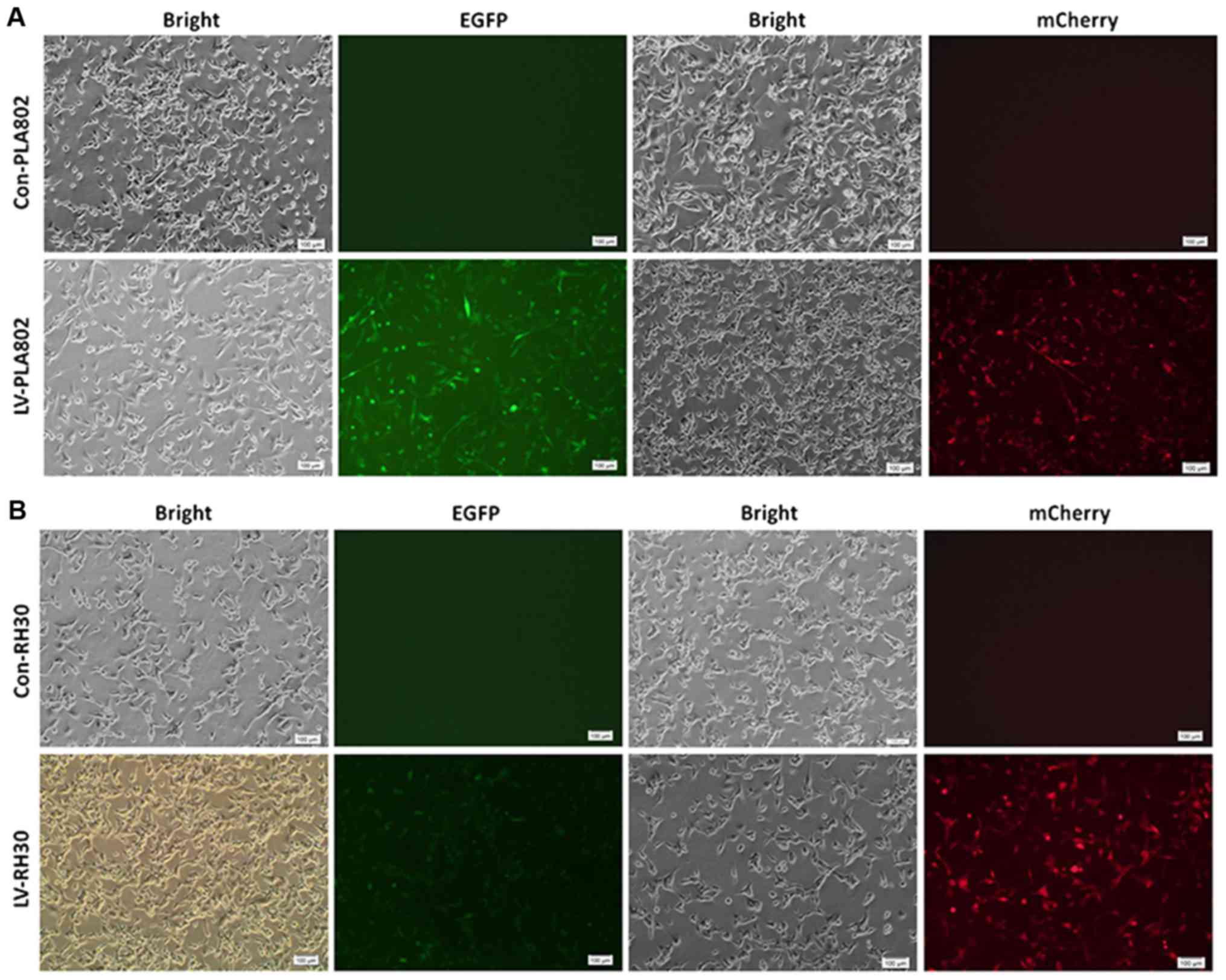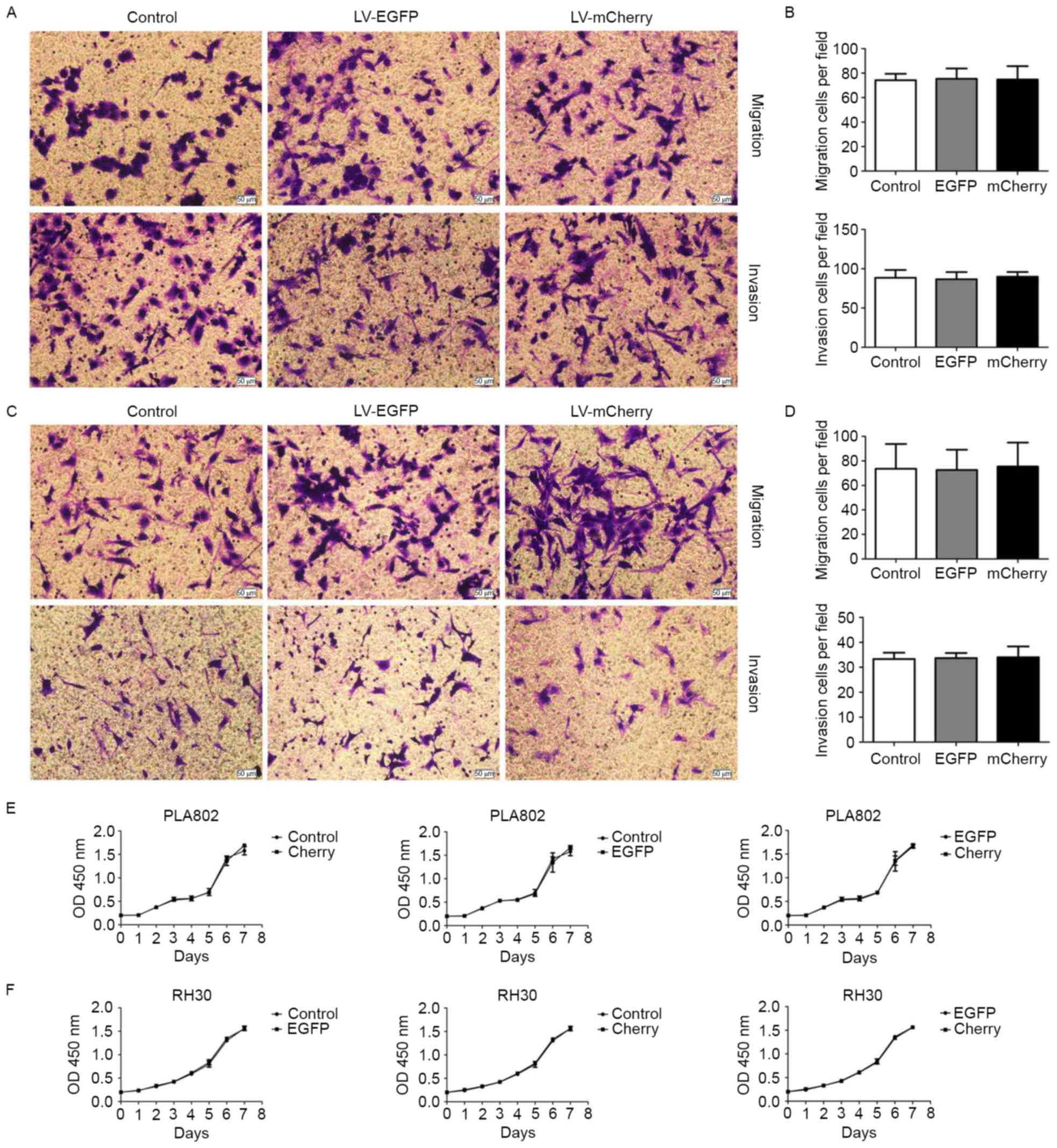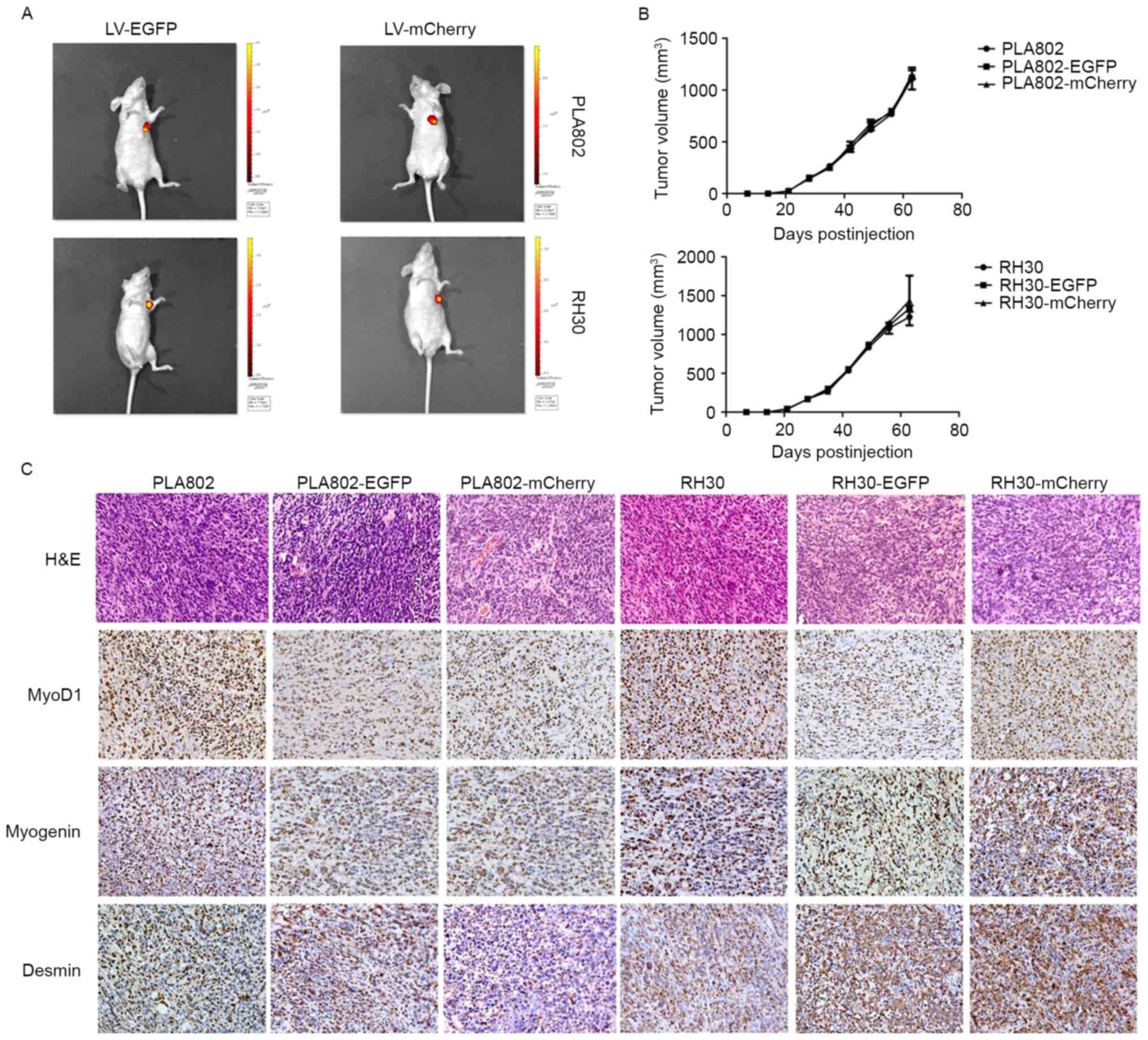|
1
|
Kashi VP, Hatley ME and Galindo RL:
Probing for a deeper understanding of rhabdomyosarcoma: Insights
from complementary model systems. Nat Rev Cancer. 15:426–439. 2015.
View Article : Google Scholar : PubMed/NCBI
|
|
2
|
Parham DM and Ellison DA:
Rhabdomyosarcomas in adults and children: An update. Arch Pathol
Lab Med. 130:1454–1465. 2006.PubMed/NCBI
|
|
3
|
Zhang M, Linardic CM and Kirsch DG: RAS
and ROS in rhabdomyosarcoma. Cancer Cell. 24:689–691. 2013.
View Article : Google Scholar : PubMed/NCBI
|
|
4
|
Erratum: Inhibition of rhabdomyosarcoma
cell and tumor growth by targeting specificity protein (sp)
transcription factors. Int J Cancer. 137:E92015. View Article : Google Scholar : PubMed/NCBI
|
|
5
|
Hinson AR, Jones R, Crose LE, Belyea BC,
Barr FG and Linardic CM: Human rhabdomyosarcoma cell lines for
rhabdomyosarcoma research: Utility and pitfalls. Front Oncol.
3:1832013. View Article : Google Scholar : PubMed/NCBI
|
|
6
|
Ebe T: Green fluorescent protein as a
marker gene expression. Tanpakushitsu Kakusan Koso. 52(Suppl 13):
1766–1767. 2007.(In Japanese). PubMed/NCBI
|
|
7
|
Zhang Q, Walawage SL, Tricoli DM, Dandekar
AM and Leslie CA: A red fluorescent protein (DsRED) from discosoma
sp. as a reporter for gene expression in walnut somatic embryos.
Plant Cell Rep. 34:861–869. 2015.
|
|
8
|
Katoh A, Shoguchi K, Matsuoka H, Yoshimura
M, Ohkubo JI, Matsuura T, Maruyama T, Ishikura T, Aritomi T,
Fujihara H, et al: Fluorescent visualisation of the hypothalamic
oxytocin neurones activated by cholecystokinin-8 in rats expressing
c-fos-enhanced green fluorescent protein and oxytocin-monomeric red
fluorescent protein 1 fusion transgenes. J Neuroendocrinol.
26:341–347. 2014. View Article : Google Scholar : PubMed/NCBI
|
|
9
|
Fink D, Wohrer S, Pfeffer M, Tombe T, Ong
CJ and Sorensen PH: Ubiquitous expression of the monomeric red
fluorescent protein mCherry in transgenic mice. Genesis.
48:723–729. 2010. View Article : Google Scholar : PubMed/NCBI
|
|
10
|
Rossetti M, Cavarelli M, Gregori S and
Scarlatti G: HIV-derived vectors for gene therapy targeting
dendritic cells. Adv Exp Med Biol. 762:239–261. 2013. View Article : Google Scholar : PubMed/NCBI
|
|
11
|
Chang LJ and He J: Retroviral vectors for
gene therapy of AIDS and cancer. Curr Opin Mol Ther. 3:468–475.
2001.PubMed/NCBI
|
|
12
|
Shichinohe T, Bochner BH, Mizutani K,
Nishida M, Hegerich-Gilliam S, Naldini L and Kasahara N:
Development of lentiviral vectors for antiangiogenic gene delivery.
Cancer Gene Ther. 8:879–889. 2001. View Article : Google Scholar : PubMed/NCBI
|
|
13
|
Dancsok AR, Asleh-Aburaya K and Nielsen
TO: Advances in sarcoma diagnostics and treatment. Oncotarget.
8:7068–7093. 2017. View Article : Google Scholar : PubMed/NCBI
|
|
14
|
Shern JF, Yohe ME and Khan J: Pediatric
rhabdomyosarcoma. Crit Rev Oncog. 20:227–243. 2015. View Article : Google Scholar : PubMed/NCBI
|
|
15
|
Casini N, Forte IM, Mastrogiovanni G,
Pentimalli F, Angelucci A, Festuccia C, Tomei V, Ceccherini E, Di
Marzo D, Schenone S, et al: SRC family kinase (SFK) inhibition
reduces rhabdomyosarcoma cell growth in vitro and in vivo and
triggers p38 MAP kinase-mediated differentiation. Oncotarget.
6:12421–12435. 2015. View Article : Google Scholar : PubMed/NCBI
|
|
16
|
Liu C, Li D, Jiang J, Hu J, Zhang W, Chen
Y, Cui X, Qi Y, Zou H, Zhang W and Li F: Analysis of molecular
cytogenetic alteration in rhabdomyosarcoma by array comparative
genomic hybridization. PloS One. 9:e949242014. View Article : Google Scholar : PubMed/NCBI
|
|
17
|
Ntziachristos V, Ripoll J, Wang LV and
Weissleder R: Looking and listening to light: The evolution of
whole-body photonic imaging. Nat Biotechnol. 23:313–320. 2005.
View Article : Google Scholar : PubMed/NCBI
|
|
18
|
Maggi A and Ciana P: Reporter mice and
drug discovery and development. Nat Rev Drug Discov. 4:249–255.
2005. View
Article : Google Scholar : PubMed/NCBI
|
|
19
|
Dubey P: Reporter gene imaging of immune
responses to cancer: Progress and Challenges. Theranostics.
2:355–362. 2012. View Article : Google Scholar : PubMed/NCBI
|
|
20
|
Martelli C, Dico AL, Diceglie C, Lucignani
G and Ottobrini L: Optical imaging probes in oncology. Oncotarget.
7:48753–48787. 2016. View Article : Google Scholar : PubMed/NCBI
|
|
21
|
Hoffman RM: The multiple uses of
fluorescent proteins to visualize cancer in vivo. Nat Rev Cancer.
5:796–806. 2005. View
Article : Google Scholar : PubMed/NCBI
|
|
22
|
Hoffman RM: Fluorescent proteins as
visible in vivo sensors. Prog Mol Biol Transl Sci. 113:389–402.
2013. View Article : Google Scholar : PubMed/NCBI
|
|
23
|
Weissleder R: Molecular imaging: Exploring
the next frontier. Radiology. 212:609–614. 1999. View Article : Google Scholar : PubMed/NCBI
|
|
24
|
Chen ZY, Wang YX, Lin Y, Zhang JS, Yang F,
Zhou QL and Liao YY: Advance of molecular imaging technology and
targeted imaging agent in imaging and therapy. Biomed Res Int.
2014:8193242014.PubMed/NCBI
|
|
25
|
Liu K, Wang MW, Lin WY, Phung DL, Girgis
MD, Wu AM, Tomlinson JS and Shen CK: Molecular imaging probe
development using microfluidics. Curr Org Synth. 8:473–487. 2011.
View Article : Google Scholar : PubMed/NCBI
|
|
26
|
Hillman EM, Amoozegar CB, Wang T, McCaslin
AF, Bouchard MB, Mansfield J and Levenson RM: In vivo optical
imaging and dynamic contrast methods for biomedical research.
Philos Trans A Math Phys Eng Sci. 369:4620–4643. 2011. View Article : Google Scholar : PubMed/NCBI
|
|
27
|
Chalfie M, Tu Y, Euskirchen G, Ward WW and
Prasher DC: Green fluorescent protein as a marker for gene
expression. Science. 263:802–805. 1994. View Article : Google Scholar : PubMed/NCBI
|
|
28
|
Adusumilli PS, Eisenberg DP, Stiles BM,
Chung S, Chan MK, Rusch VW and Fong Y: Intraoperative localization
of lymph node metastases with a replication-competent herpes
simplex virus. J Thorac Cardiovasc Surg. 132:1179–1188. 2006.
View Article : Google Scholar : PubMed/NCBI
|
|
29
|
Shen Y, Chen Y, Wu J, Shaner NC and
Campbell RE: Engineering of mCherry variants with long Stokes
shift, red-shifted fluorescence, and low cytotoxicity. PLoS One.
12:e01712572017. View Article : Google Scholar : PubMed/NCBI
|
|
30
|
Shen Y, Lai T and Campbell RE: Red
fluorescent proteins (RFPs) and RFP-based biosensors for neuronal
imaging applications. Neurophotonics. 2:0312032015. View Article : Google Scholar : PubMed/NCBI
|
|
31
|
Piatkevich KD and Verkhusha VV: Advances
in engineering of fluorescent proteins and photoactivatable
proteins with red emission. Curr Opin Chem Biol. 14:23–29. 2010.
View Article : Google Scholar : PubMed/NCBI
|
|
32
|
Campbell RE, Tour O, Palmer AE, Steinbach
PA, Baird GS, Zacharias DA and Tsien RY: A monomeric red
fluorescent protein. Proc Natl Acad Sci USA. 99:7877–7882. 2002.
View Article : Google Scholar : PubMed/NCBI
|
|
33
|
Merzlyak EM, Goedhart J, Shcherbo D,
Bulina ME, Shcheglov AS, Fradkov AF, Gaintzeva A, Lukyanov KA,
Lukyanov S, Gadella TW and Chudakov DM: Bright monomeric red
fluorescent protein with an extended fluorescence lifetime. Nat
Methods. 4:555–557. 2007. View Article : Google Scholar : PubMed/NCBI
|
|
34
|
Shaner NC, Campbell RE, Steinbach PA,
Giepmans BN, Palmer AE and Tsien RY: Improved monomeric red, orange
and yellow fluorescent proteins derived from discosoma sp. red
fluorescent protein. Nat Biotechnol. 22:1567–1572. 2004. View Article : Google Scholar
|
|
35
|
Merten OW, Hebben M and Bovolenta C:
Production of lentiviral vectors. Mol Ther Methods Clin Dev.
3:160172016. View Article : Google Scholar : PubMed/NCBI
|
|
36
|
Rashidian M, Dozier JK and Distefano MD:
Chemoenzymatic labeling of proteins: Techniques and approaches.
Bioconjug Chem. 24:1277–1294. 2013. View Article : Google Scholar : PubMed/NCBI
|
|
37
|
Lee K, Majumdar MK, Buyaner D, Hendricks
JK, Pittenger MF and Mosca JD: Human mesenchymal stem cells
maintain transgene expression during expansion and differentiation.
Mol Ther. 3:857–866. 2001. View Article : Google Scholar : PubMed/NCBI
|

















